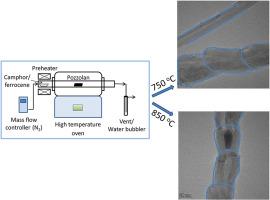当前位置:
X-MOL 学术
›
Mater. Today Chem.
›
论文详情
Our official English website, www.x-mol.net, welcomes your feedback! (Note: you will need to create a separate account there.)
Effect of processing temperature on growing bamboo-like carbon nanotubes by chemical vapor deposition
Materials Today Chemistry ( IF 7.3 ) Pub Date : 2021-03-01 , DOI: 10.1016/j.mtchem.2020.100388 T. Giannakopoulou , G. Pilatos , N. Todorova , N. Boukos , T. Vaimakis , I. Karatasios , C. Trapalis
Materials Today Chemistry ( IF 7.3 ) Pub Date : 2021-03-01 , DOI: 10.1016/j.mtchem.2020.100388 T. Giannakopoulou , G. Pilatos , N. Todorova , N. Boukos , T. Vaimakis , I. Karatasios , C. Trapalis

|
Abstract The present article demonstrates a simple, eco-friendly route for the fabrication of carbon nanotubes (CNTs) with different morphologies, including the fascinating bamboo-like structures without complex catalyst/support preparation procedures. A thermal chemical vapor deposition (CVD) technique that utilized natural pozzolan supports and a solid carbon source, that is, a mixture of camphor and ferrocene in a weight ratio of 20:1, was carried out at different temperatures where the ferrocene played also the role of catalyst. The pozzolan chemical composition and mineral identification were determined by energy dispersive X-ray spectroscopy (EDS), X-ray diffraction (XRD) and Fourier transform infrared (FT-IR) spectroscopy. The morphology of the fabricated CNTs was studied via scanning and transmission electron microscopies (SEM and TEM). It was revealed that both conventional tubular and bamboo-like nanotubes grow at 750 °C while the bamboo-like morphology prevails at 850 °C. The better nanostructure uniformity at higher deposition temperature was accompanied by an improved nanotube graphitization degree that was verified by Raman spectroscopy. Yet, the reduction of the CNTs production yield was recorded by thermogravimetric analysis (TGA). The experimental data are interpreted and discussed as an interplay between the CNTs processing temperature, morphology and growth mechanism. Thus, the growth of either tubular or bamboo-like nanostructures is suggested to be ruled by the competitive surface and bulk diffusions of carbon onto and into the catalyst surface. The growth depends on the size of catalyst nanoparticles sintered at different temperatures. The favorable role of the pozzolan supporting materials in the formation of bamboo-like tubes is emphasized.
中文翻译:

加工温度对化学气相沉积法生长竹状碳纳米管的影响
摘要 本文展示了一种简单、环保的制备具有不同形态的碳纳米管 (CNT) 的途径,包括迷人的竹状结构,无需复杂的催化剂/载体制备程序。利用天然火山灰载体和固体碳源,即重量比为 20:1 的樟脑和二茂铁的混合物,在不同温度下进行热化学气相沉积 (CVD) 技术,其中二茂铁还起到催化剂的作用。通过能量色散 X 射线光谱 (EDS)、X 射线衍射 (XRD) 和傅里叶变换红外 (FT-IR) 光谱确定火山灰的化学成分和矿物鉴定。通过扫描和透射电子显微镜(SEM 和 TEM)研究制造的 CNT 的形态。结果表明,传统的管状和竹状纳米管都在 750°C 下生长,而竹状形态在 850°C 下盛行。在更高的沉积温度下更好的纳米结构均匀性伴随着纳米管石墨化程度的提高,拉曼光谱证实了这一点。然而,通过热重分析 (TGA) 记录了 CNT 产量的降低。实验数据被解释和讨论为碳纳米管加工温度、形态和生长机制之间的相互作用。因此,管状或竹状纳米结构的生长被认为是由碳在催化剂表面上和进入催化剂表面的竞争表面和本体扩散所控制的。生长取决于在不同温度下烧结的催化剂纳米颗粒的尺寸。
更新日期:2021-03-01
中文翻译:

加工温度对化学气相沉积法生长竹状碳纳米管的影响
摘要 本文展示了一种简单、环保的制备具有不同形态的碳纳米管 (CNT) 的途径,包括迷人的竹状结构,无需复杂的催化剂/载体制备程序。利用天然火山灰载体和固体碳源,即重量比为 20:1 的樟脑和二茂铁的混合物,在不同温度下进行热化学气相沉积 (CVD) 技术,其中二茂铁还起到催化剂的作用。通过能量色散 X 射线光谱 (EDS)、X 射线衍射 (XRD) 和傅里叶变换红外 (FT-IR) 光谱确定火山灰的化学成分和矿物鉴定。通过扫描和透射电子显微镜(SEM 和 TEM)研究制造的 CNT 的形态。结果表明,传统的管状和竹状纳米管都在 750°C 下生长,而竹状形态在 850°C 下盛行。在更高的沉积温度下更好的纳米结构均匀性伴随着纳米管石墨化程度的提高,拉曼光谱证实了这一点。然而,通过热重分析 (TGA) 记录了 CNT 产量的降低。实验数据被解释和讨论为碳纳米管加工温度、形态和生长机制之间的相互作用。因此,管状或竹状纳米结构的生长被认为是由碳在催化剂表面上和进入催化剂表面的竞争表面和本体扩散所控制的。生长取决于在不同温度下烧结的催化剂纳米颗粒的尺寸。


























 京公网安备 11010802027423号
京公网安备 11010802027423号